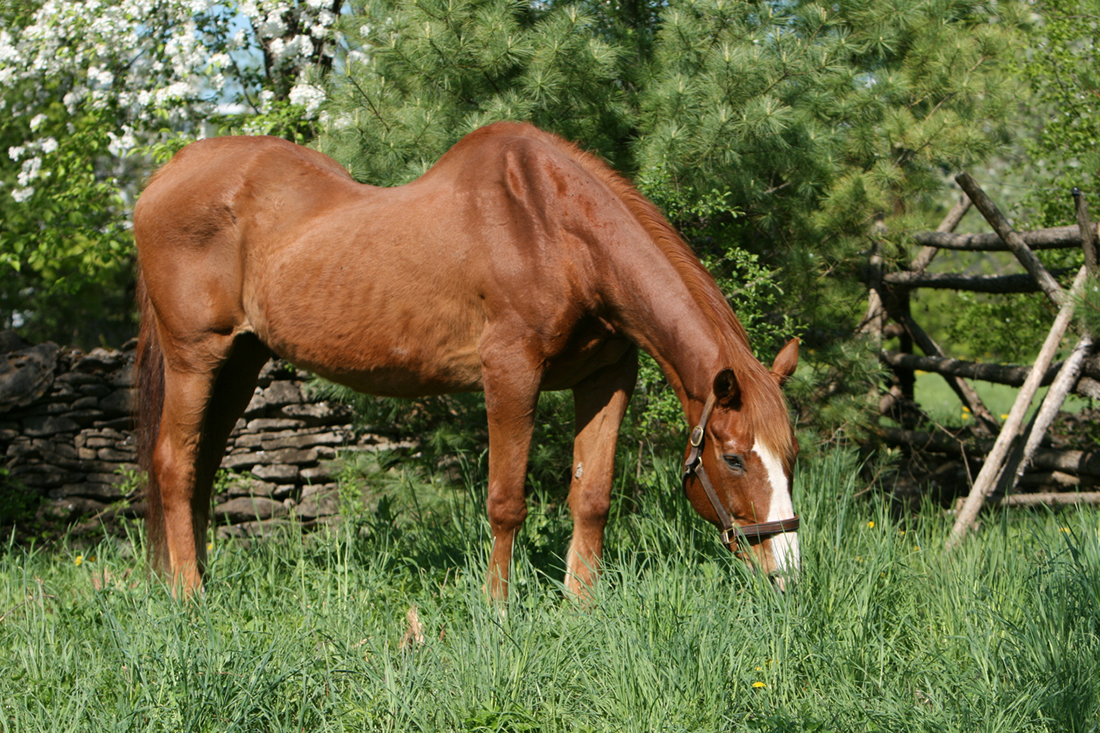Cushing’s Disease (Pituitary pars intermedia dysfunction/PPID) in horses occurs when there is a tumor on the pituitary gland, an organ at the base of the brain. This tumor causes the pituitary gland to over-produce ACTH, a hormone that affects cortisol levels in the body.
To explain, cortisol is a steroid usually released as a response to stress, controlling carbohydrates, fats, proteins, and the immune system.
When this and other hormones are overproduced, serious health issues arise. In addition to humans, this disease affects other mammals, such as dogs, ponies, and horses.
Signs of Equine Cushing’s Disease
In horses, this particular branch of the disease is known as Equine Cushing’s Disease (ECD). This form of the disease is most commonly found in older horses, specifically ones in their 20’s and 30’s.
One of the most obvious signs of this disease is known as hirsuitism, a condition where the horse stops shedding normally and continues to grow an abnormally long, curly coat. Other symptoms include:
- fat redistribution
- exhaustion
- excessive drinking and urination
- muscle mass loss
- infertility
- abscesses
Sometimes an affected horse can develop laminitis, a painful foot disease.

Diagnosis of Equine Cushing’s Disease
There are two main clinical tests that can determine (without 100% accuracy) that a horse has ECD: the dexamethasone suppression test (DST) and ACTH (adrenocorticotropic hormone) stimulation.
Although there is no cure for ECD, with proper medical care, symptoms can be suppressed.
How to Manage Cushing’s Disease in Your Horse
There are many ways to manage and improve the quality of life of a horse with this disease. Firstly, because their coats become so thick year-round, regular clipping keeps the horse more comfortable during warmer seasons.
In addition to exercise and careful dental and foot care, a horse’s diet must be altered.
Oftentimes horses with ECD have high blood sugar and are insulin resistant, that is, their cells are not responsive to the hormone.
Insulin allows sugars to be absorbed by cells and when this process does not work, the sugar remains in the bloodstream and turns into fat. This is what causes irregular fat distribution in horses with EDC.
If this is the case, the best feed for the horse is one low in starch and sugar. Also, Vitamin E and C are known to be helpful additions to the horse’s diet. Nutritional supplements may be provided as well.
ECD Treatments
In addition to a diet change, the horse can be given special medication to increase dopamine production in the brain (an important chemical that helps control things such as attention, pleasure, cognition, and even movement).
One popular example of this medicine is pergolide. Others include bromocriptine, trilostane, and cyproheptadine.
However, once these medications are given to the horse, they must continue to be provided for the rest of the horse’s life. Although medicine and health management can help the horse live a comfortable life for several years, neither option can stop the tumor.
References
- Adams, M. Managing Equine Cushing’s Disease with Nutrition. In Southern States. n.d.
- Eustace, R. A. Equine Cushing’s Disease. In Laminitis. 1991.
- Lindop, J. Understanding Cushing’s Disease. In Horse and Hound. September 2, 2005.
- Wilson, J. D. Cushing’s Disease in Horses. In Equus. n.d.
- Wow Horses. Cushing’s Disease. In Wow Horses. 2009.
- Posnikoff, J. Advances Against Cushing’s Disease. In Horse Illustrated. n.d.
- Equine Health. Equine Cushing’s Disease. In My Equine Clinic. June 27, 2012.












Hello: This is not a comment, but is a question. Do you know where to purchase brand name Prascend in Canada? (Pergolide Mesylate) with a vet prescription for horses? Thank you, Wendy
Hi Wendy,
You can get Prascend in Canada directly from your vet.